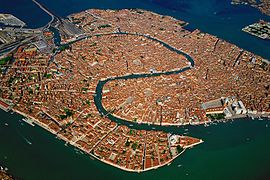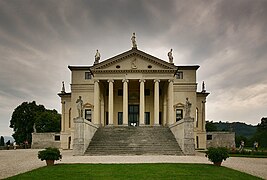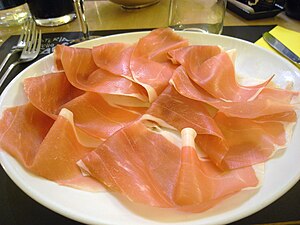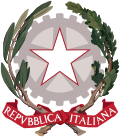Northern Italy or Northern Italy is the most populous and economically strongest part of the country Italy.

Regions

- Aosta Valley - French-speaking area in the Alps.
- Emilia-Romagna
- Friuli Venezia Giulia
- Liguria - here are the Italian Riviera and Cinque Terre.
- Lombardy (Lombardia) with very different landscape forms; in the north the Alps and in the south the Po plain.
- Piedmont (Piedmont)
- Trentino-South Tyrol in the Alps
- South-Tirol, autonomous province, mostly German-speaking
- Trentino, autonomous province, mostly Italian-speaking
- Veneto
places


- 1 Bologna
 - important trade and trade fair city.
- important trade and trade fair city. - 2 Genoa
 (Genova) - a lively and at the same time historical port city, birthplace of Columbus.
(Genova) - a lively and at the same time historical port city, birthplace of Columbus. - 3 Milan
 (Milano) - largest city in Northern Italy; communicates Paris the title "Fashion Capital of the World" and is the economic capital of Italy.
(Milano) - largest city in Northern Italy; communicates Paris the title "Fashion Capital of the World" and is the economic capital of Italy. - 4 Turin
 (Torino) - the first capital of modern Italy and the venue for the 2006 Winter Olympics.
(Torino) - the first capital of modern Italy and the venue for the 2006 Winter Olympics. - 5 Venice
 (Venezia) - famous for art and history. The city has no highways, but all the more canals.
(Venezia) - famous for art and history. The city has no highways, but all the more canals.
- 6 Bolzano
 (Bolzano) - Capital of South-Tirol.
(Bolzano) - Capital of South-Tirol. - 7 Parma
 - Home of Parma ham and Parmesan cheese.
- Home of Parma ham and Parmesan cheese. - 8 Trieste
 (Trieste) - Former port city of the Habsburg Monarchy, at the intersection of the Italian, Austrian and Slavic cultural areas.
(Trieste) - Former port city of the Habsburg Monarchy, at the intersection of the Italian, Austrian and Slavic cultural areas. - 9 Verona
 - on the southern edge of the Alps, here is the world-famous arena and the locations of "Romeo and Juliet".
- on the southern edge of the Alps, here is the world-famous arena and the locations of "Romeo and Juliet".
Other goals
- The 1 Lake garda
 in Trentino, a mecca for surfers and mountain bikers
in Trentino, a mecca for surfers and mountain bikers - The 2 Lake Maggiore on the border between Italy and Switzerland
- The 3 Lake Como is known for its villas
- The 4 Lake Lugano is mostly in Switzerland but has Italian areas that are well worth seeing
background
Upper Italy is the part of Italy that historically has the closest ties to Central Europe.
Ancient and Middle Ages

Settled here in ancient times celtic Tribes. The Romans therefore referred to the region as Gallia Cisalpina ("Gaul this side of the Alps" - seen from Rome). It was conquered by Rome during the Second Punic War against Hannibal (end of the 3rd century BC). Important city foundations from Roman times are Placentia (Piacenza), Cremona, Ravenna, Genoa (Genoa), Mediolanum (Milan), Aquileia and Verona. Among other things, this was the home of the Latin writers Catullus, Virgil, Pliny the Elder and the Younger. The Milan Edict of Tolerance allowed the spread of the Christianity. Milan, Ravenna and Aquileia are important sites of early Christian architecture and art.
Towards the end of Roman times, Upper Italy was overrun by various Germanic tribes, some of which also settled here. As a result, blonde and blue-eyed northern Italians are not such a rare sight. The Lombards ruled over large parts of northern Italy until 774, while the exarchate of Ravenna on the Adriatic coast belonged to the Eastern Roman Empire (Byzantium) until 751. At the end of the 8th century, all of Northern Italy was incorporated into the Frankish Empire. From that it developed Holy Roman Empire, to which also today's Germany, Austria and Switzerland belonged. Historians also refer to Upper Italy, which belonged to the empire, as "Imperial Italy", in contrast to southern Italy, which did not belong to the empire.
_vestito_con_bandiere_contrada_)
Formed in the high Middle Ages City-states that in fact enjoyed extensive autonomy within the empire and were mostly ruled by a noble family or an aristocratic elite. Important examples are those Seafaring Republics Genoa and Venice (which from around 1000 built its own colonial empire in the eastern Mediterranean that reached as far as Cyprus) and the cities of the Lombard League around Milan, which rebelled against Emperor Frederick I Barbarossa in the 12th century. The UniversitiesBologna, Parma, Vicenza and Padua - founded in the 10th to 13th centuries - are among the oldest in Europe.
Modern times
_-_The_Last_Supper_(1495-1498).jpg/220px-Leonardo_da_Vinci_(1452-1519)_-_The_Last_Supper_(1495-1498).jpg)
The cities of Northern Italy acquired through theirs trade great wealth. The modern European Banking had its origin here. As a result, terms like Lombard loan and numerous Italian loan words from the banking and finance sector (e.g. bankruptcy, balance sheet, account) in the German vocabulary. The prosperity of northern Italian aristocrats and merchants also enabled art to flourish, which is now known as Renaissance referred to as. In Northern Italy lived and worked among others. Giotto, Donatello, Leonardo da Vinci (his world famous Last Supper can be seen in the original in Milan) and Titian, to name just the most famous. Andrea Palladio, one of the most important architects of the Renaissance, created primarily country villas in Veneto, but also city palaces, churches, bridges and theaters.
In the 18th century, parts of northern Italy belonged to the duchies of Milan, Parma, Modena - to the domain of the Austrian Habsburgs. The westernmost part of northern Italy, Piedmont, on the other hand, belonged to the Duchy of Savoy, whose rulers were also kings of Sardinia from 1720. The north-east belonged to the Republic of Venice until Napoleon's invasion and the complete territorial reorganization of Italy. Some of the greatest Italian Composers came from northern Italy or celebrated their greatest successes here - this includes, among others. Vivaldi, Salieri, Rossini and Verdi. Numerous well-known Operas were premiered at La Scala in Milan, and to this day it is one of the most important opera houses in the world. But the Teatro La Fenice in Venice should also be familiar to every opera connoisseur.

After the defeat of Napoleon and the Congress of Vienna in 1815, the Lombardy-Venetian Kingdom existed in northern Italy, a subsidiary of the Austrian Empire. The duchies of Parma and Modena retained their independence until the national unification of Italy in 1860, Romagna meanwhile belonged to the papal papal state. The Risorgimento, d. H. the endeavor of all of Italy in one Nation state to agree, went essentially from Sardinia-Piedmont, whose ruler Victor Emanuel II declared himself king of Italy in 1861. As a result was Turin the first capital of united Italy. Camillo Count von Cavour, the first Prime Minister of the Kingdom of Italy, was also a Piedmontese. Giuseppe Mazzini and Giuseppe Garibaldi, the two masterminds and heroes of the national liberation struggle, came from Liguria.

The industrialization Italy was mainly concentrated in northern Italy, while the south remained agricultural. Even 150 years after the unification of Italy, there is a considerable wealth gap between north and south. Almost all major Italian industrial companies are based in the northern regions, above all the car manufacturers Fiat and Lancia (Turin), Alfa Romeo (originally Portello near Milan, now also Turin), Lamborghini (Sant'Agata near Bologna), Ferrari (Maranello, province Modena) and Maserati (Modena). The world-famous typewriter manufacturer Olivetti (later also electronic office equipment and computers) has its headquarters in Ivrea near Turin.
The north also benefited more than the south from the Italian economic miracle of the 1950s and 1960s. Since then, pride in one's own region has been widespread, but sometimes also an arrogant “looking down” on the less developed south. Many northern Italians are no longer willing to share their wealth through transfer payments to the central government in Rome and the poorer southern regions. Since the 1980s, parties have experienced the after autonomy for the respective regions strive for an upswing. The Lega Nord, to which several regional parties joined together in 1989, even called for the independence of "Padania" (i.e. the Po Valley or northern Italy) from Italy for a time. In the meantime, however, it is primarily directed against the EU and against immigrants. In some parts of northern Italy (especially Lombardy and Veneto) the Lega Nord is the strongest party and provides mayors and even regional presidents. In contrast, Emilia-Romagna traditionally belongs to the "red" regions, i. H. the strongholds of the Communist Party and, since 1991, the center-left parties.
language
Italian is the most widely spoken. In addition, depending on the region, German (South Tyrolean dialect), Ladin (South Tyrol), Furlan (Friuli) and French (Aosta Valley) are also used.
The northern Italian dialects (Venetian, Lombard, Piedmontese, Ligurian, Emilian-Romagnolian) are very different from standard Italian, so that some linguists consider them to be languages in their own right. However, standard Italian is spoken everywhere to outsiders.
getting there
By plane
Northern Italy has a number of major international airports: The Two Milanese Airports Malpensa (MXP) and Linate (LIN), Bergamo (BGY), Venice (VCE) and Bologna (BLQ). Follow with a little distance Turin (TRN), Verona (VRN), Treviso (TSF) and Trieste (TRS), which are a little less frequented, but also have direct connections from D / A / CH.
By train

Northern Italy has good rail connections with Central Europe. The most important lines from the German-speaking area are the Eurocity over the Brenner (Munich–innsbruck–Bolzano–Verona) every two hours, also the two-hour EC Zurich-Milan; the EC three times a day Basel–Bern-Milan; the RailJet twice a day Vienna–Klagenfurt–Udine–Venice and the EC Munich – Innsbruck–Bologna; once a day the Eurocity-Express (ECE) from Frankfurt am Main and Karlsruhe to Milan or the EC from Munich and Innsbruck to Venice. The drive from Zurich to Milan takes just under 3½ hours, from Munich to Verona 5½ hours, from Vienna to Venice 7½ hours.
Night trains (ÖBB NightJet) connect Vienna, Munich, Linz and Salzburg with Venice, Verona, the Lake garda, Milan and Bologna.
A special way to travel from Switzerland to Northern Italy is to take the Rhaetian Railway's Bernina Line on the spectacular route from St. Moritz to Tirano (Province of Sondrio, Lombardy), which is a World Heritage Site.
Within Italy, the north can be reached quickly from Rome by high-speed trains Frecciarossa or Italo: Rome – Bologna 2 hours, Verona 2:50 hours, Milan 3 hours, Venice 3:45 hours, Turin 4 hours
By bus
There are numerous long-distance bus connections from German-speaking countries from Flixbus and other providers to the cities of Northern Italy.
In the street
The most frequented alpine crossings from the German-speaking area to Northern Italy are via the Brenner (from Munich / Innsbruck to South Tyrol / Verona), through the Gotthard tunnel (from Zurich / Lucerne to Milan) or via the Austrian south motorway (from Villach to Udine / Venice / Trieste ).
By bicycle

Long-distance bike paths across the Alps are the Via Claudia Augusta from Donauwörth via Füssen, Bozen and Trento to Venice; the Via Romea Francigena (EuroVelo 5) from Basel via Lucerne and Andermatt to Milan; the "Sun Route" (EuroVelo 7) from Linz via Salzburg and Lienz to Lake Garda; and the Ciclovia Alpe Adria bike path (CAAR) from Salzburg via Villach to Grado on the Gulf of Venice.
mobility

High-speed trains connect the regions of Northern Italy with one another. For example, the Frecciarossa Milan – Verona – Venice or Milan – Bologna runs every half hour, every second train continues to Turin, several trains a day to Trieste or Udine. The journey from Milan to Venice or vice versa takes less than 2½ hours, from Milan to Bologna just an hour. In general, Northern Italy has a well-developed railway network, smaller towns can be reached by regional (express) trains.
If you want to move around in rural regions or visit sights outside of cities, an individual vehicle is an advantage. Compared to southern Italy, it is said that the driving style of northern Italians is more like that of Central Europe. In view of the narrow streets both in the mountain regions and in the city centers, smaller models are preferable. But it is even better not to drive into the old towns at all, especially since many Italian cities have set up traffic-calmed zones that can only be driven through by residents with a permit. Disregarding these zones (as well as speed limits and other rules) are punishable by heavy fines.
Tourist Attractions
Only a selection of internationally significant highlights can be found here. Many other sights can be found in the regional, provincial and city articles.
- Liguria
- Porto Venere and Cinque Terre with the islands of Palmaria, Tino and Tinetto
- Lombardy
- Church and Dominican monastery of Santa Maria delle Grazie in Milan with the Lord's Supper by Leonardo da Vinci
- Renaissance cities Mantua and Sabbioneta
- Bernina Railway from St. Moritz (Switzerland) to Tirano (Province of Sondrio)
.jpg/272px-Cinque_Terre_DSC_6954_(14250460371).jpg)
Manarola, Cinque Terre
.jpg/347px-Theater_Sabbioneta_(13384718983).jpg)
Sabbioneta Theater

Bernina Railway in Tirano
- Emilia-Romagna
- Early Christian buildings in Ravenna
- The renaissance old town of Ferrara as well as the Po Delta
- Cathedral of Modena, Bell tower and Piazza Grande

Ceiling mosaic in San Vitale, Ravenna
.jpg/270px-Piazza_castello_(Ferrara).jpg)
Estense Castle, Ferrara

Modena: cathedral and bell tower
- Veneto
- Friuli Venezia Giulia
- Archaeological sites from Roman times and Romanesque basilica of Aquileia

Venice aerial view

Verona old town

Palladian Villa La Rotonda
.jpg/272px-Aquileia,_Italy_(19553264520).jpg)
Aquileia Basilica
activities

- Several of the most important opera houses in the world are located in Northern Italy, above all La Scala in Milan, the Teatro La Fenice in Venice and the Arena in Verona.
- Winter sports in the Alps and Dolomites (e.g. Seiser Alm, Solda, Cortina d'Ampezzo, Livigno, Sella group, Alta Badia)
kitchen
Contrary to the pizza-and-pasta cliché of Italian cuisine, rice or rice is traditionally used in the Po Valley polenta (Corn semolina porridge) eaten as a starch supplier. Risotto is thus a typical northern Italian tradition, e.g. B. is the recipe for Risi e bisi (Risotto with peas) from Veneto, Risotto Alla Milanese (Saffron risotto) from Milan. Pizza, on the other hand, is actually a southern Italian dish and only later spread to the north. Typically Northern Italian, however, is the Focaccia, originally a specialty from Liguria. Even the classic one Pesto alla genovese, which is now common all over Italy, has its origin in this region.
In the areas that were formerly part of Austria (especially South Tyrol, Trentino, Trieste and Gorizia) there is a strong one more Austrian Determine influence in the culinary arts. On the other hand, there is also a northern Italian influence on Austrian cuisine. B. probably that Cotoletta alla milanese Model for the Wiener Schnitzel.
Well-known products from Northern Italy:
- Parma is the city of ParmesanCheese and des Parma ham.
- A little less known internationally, but at least as high quality San Daniele ham from Friuli.
- South Tyrolean bacon(Bacon Alto Adige) also belongs to the range of high-quality Northern Italian ham specialties
- Grana Padano-Cheese is produced in large parts of northern Italy (Lombardy, Veneto, Emilia-Romagna, Piedmont).
- The famous vinegar comes from Modena Balsamic vinegar.
- Mortadella di Bologna is a sausage specialty made from pork with diced bacon and pistachios. Ragù alla bolognese, or even just Bolognese, is a pasta sauce that is now widely used and originally from Bologna.
- Dessert Tiramisu In the form known today, it was probably developed in Veneto or Friuli-Venezia Giulia. The one used for this Mascarpone-Cream cheese originally comes from Lodi in Lombardy.
- Panna cotta originally from Piedmont; also the invention of the zabaglione claims this region for itself.
- The famous sparkling wine Prosecco comes from the area of Valdobiaddene and Conegliano (Province of Treviso)
- The most famous wine-growing regions of Northern Italy also belong to it Valpolicella and Bardolino (near Verona), Barolo (Piedmont), Lambrusco (Emilia-Romagna), Lugana (south of Lake Garda) as well South-Tirol
- Vecchia Romagna is a high quality brandy from Emilia-Romagna.
- The Campari-Bitter liqueur comes from Milan, Aperol was invented in Padua.
- The origin of the Amaretto is said to be in the Lombard city of Saronno, this is where the best-known manufacturer of this bitter almond liqueur comes from.
.jpg/338px-Risotto_saffron_and_pistachio_nuts_(32645475042).jpg)
Risotto Alla Milanese

Prosciutto di Parma
Amaretto from various manufacturers








.jpg/350px-Trieste_(28766391880).jpg)



,_seen_from_the_mountain_Monte_Grona_-_Plesio_(Como)_2015-10-25.JPG/350px-Panoramic_view_of_Como_Lake_(Lago_di_Como),_seen_from_the_mountain_Monte_Grona_-_Plesio_(Como)_2015-10-25.JPG)

.jpg/272px-Cinque_Terre_DSC_6954_(14250460371).jpg)
.jpg/347px-Theater_Sabbioneta_(13384718983).jpg)


.jpg/270px-Piazza_castello_(Ferrara).jpg)




.jpg/272px-Aquileia,_Italy_(19553264520).jpg)
.jpg/338px-Risotto_saffron_and_pistachio_nuts_(32645475042).jpg)


